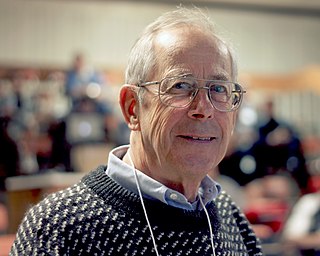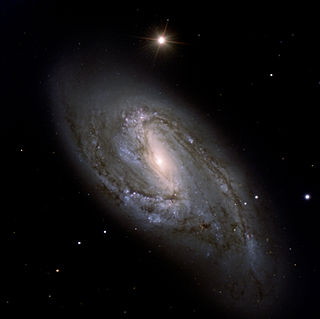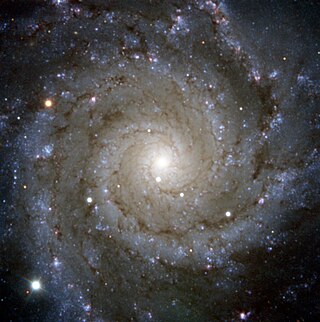The Petrie Prize Lecture is an award given in alternate years by the Canadian Astronomical Society to an outstanding astrophysicist. The award commemorates the contributions to astrophysical research of the Canadian astronomer Robert M. Petrie. [1]
The Petrie Prize Lecture is an award given in alternate years by the Canadian Astronomical Society to an outstanding astrophysicist. The award commemorates the contributions to astrophysical research of the Canadian astronomer Robert M. Petrie. [1]
Source: Canadian Astronomical Society

The Astronomical Society of the Pacific (ASP) is an American scientific and educational organization, founded in San Francisco on February 7, 1889, immediately following the solar eclipse of January 1, 1889. Its name derives from its origins on the Pacific Coast, but today it has members all over the country and the world. It has the legal status of a nonprofit organization.
The Newton Lacy Pierce Prize in Astronomy is awarded annually by the American Astronomical Society to a young astronomer for outstanding achievement in observational astronomical research. The prize is named after Newton Lacy Pierce, an American astronomer.

Phillip James Edwin Peebles is a Canadian-American astrophysicist, astronomer, and theoretical cosmologist who was Albert Einstein Professor in Science, emeritus, at Princeton University. He is widely regarded as one of the world's leading theoretical cosmologists in the period since 1970, with major theoretical contributions to primordial nucleosynthesis, dark matter, the cosmic microwave background, and structure formation.

Messier 66 or M66, also known as NGC 3627, is an intermediate spiral galaxy in the southern, equatorial half of Leo. It was discovered by French astronomer Charles Messier on 1 March 1780, who described it as "very long and very faint". This galaxy is a member of a small group of galaxies that includes M65 and NGC 3628, known as the Leo Triplet or the M66 Group. M65 and M66 are a common object for amateur astronomic observation, being separated by only 20′.

Messier 74 is a large spiral galaxy in the equatorial constellation Pisces. It is about 32 million light-years away from Earth. The galaxy contains two clearly defined spiral arms and is therefore used as an archetypal example of a grand design spiral galaxy. The galaxy's low surface brightness makes it the most difficult Messier object for amateur astronomers to observe. Its relatively large angular size and the galaxy's face-on orientation make it an ideal object for professional astronomers who want to study spiral arm structure and spiral density waves. It is estimated that M74 hosts about 100 billion stars.
The Canadian Astronomical Society is a Canadian society of professional astronomers, founded in 1971 and incorporated in 1983. The society is devoted to the promotion and advancement of knowledge of the universe through research and education, and its membership is open to people with a professional involvement in astronomy and related sciences.

Margaret J. Geller is an American astrophysicist at the Center for Astrophysics | Harvard & Smithsonian. Her work has included pioneering maps of the nearby universe, studies of the relationship between galaxies and their environment, and the development and application of methods for measuring the distribution of matter in the universe.

Alexei Vladimir "Alex" Filippenko is an American astrophysicist and professor of astronomy at the University of California, Berkeley. Filippenko graduated from Dos Pueblos High School in Goleta, California. He received a Bachelor of Arts in physics from the University of California, Santa Barbara in 1979 and a Ph.D. in astronomy from the California Institute of Technology in 1984, where he was a Hertz Foundation Fellow. He was a postdoctoral Miller Fellow at Berkeley from 1984 to 1986 and was appointed to Berkeley's faculty in 1986. In 1996 and 2005, he was a Miller Research Professor, and he is currently a Senior Miller Fellow. His research focuses on supernovae and active galaxies at optical, ultraviolet, and near-infrared wavelengths, as well as on black holes, gamma-ray bursts, and the expansion of the Universe.

The High-Z Supernova Search Team was an international cosmology collaboration which used Type Ia supernovae to chart the expansion of the universe. The team was formed in 1994 by Brian P. Schmidt, then a post-doctoral research associate at Harvard University, and Nicholas B. Suntzeff, a staff astronomer at the Cerro Tololo Inter-American Observatory (CTIO) in Chile. The original team submitted a proposal on September 29, 1994 called A Pilot Project to Search for Distant Type Ia Supernova to the CTIO. The team on the first observing proposal comprised: Nicholas Suntzeff (PI); Brian Schmidt (Co-I); R. Chris Smith, Robert Schommer, Mark M. Phillips, Mario Hamuy, Roberto Aviles, Jose Maza, Adam Riess, Robert Kirshner, Jason Spiromilio, and Bruno Leibundgut. The project was awarded four nights of telescope time on the CTIO Víctor M. Blanco Telescope on the nights of February 25, 1995, and March 6, 24, and 29, 1995. The pilot project led to the discovery of supernova SN1995Y. In 1995, the HZT elected Brian P. Schmidt of the Mount Stromlo Observatory which is part of the Australian National University to manage the team.

SN 2006gy was an extremely energetic supernova, also referred to as a hypernova, that was discovered on September 18, 2006. It was first observed by Robert Quimby and P. Mondol, and then studied by several teams of astronomers using facilities that included the Chandra, Lick, and Keck Observatories. In May 2007, NASA and several of the astronomers announced the first detailed analyses of the supernova, describing it as the "brightest stellar explosion ever recorded". In October 2007, Quimby announced that SN 2005ap had broken SN 2006gy's record as the brightest-ever recorded supernova, and several subsequent discoveries are brighter still. Time magazine listed the discovery of SN 2006gy as third in its Top 10 Scientific Discoveries for 2007.
The Gruber Prize in Cosmology, established in 2000, is one of three prestigious international awards worth US$500,000 awarded by the Gruber Foundation, a non-profit organization based at Yale University in New Haven, Connecticut.
SN 2003H was a supernova that appeared halfway between the colliding NGC 2207 and IC 2163 galaxies. It was discovered on January 8, 2003, by the Lick Observatory and Tenagra Supernova Searches (LOTOSS).

SN 1994I is a Type Ic supernova discovered on April 2, 1994 in the Whirlpool Galaxy by amateur astronomers Tim Puckett and Jerry Armstrong of the Atlanta Astronomy Club. Type Ic supernova are a rare type of supernova that result from the explosion of a very massive star that has shed its outer layers of hydrogen and helium. The explosion results in a highly luminous burst of radiation that then dims over the course of weeks or months. SN 1994I was a relatively nearby supernova, and provided an important addition to the then small collection of known Type Ic supernova. Very early images were captured of SN 1994I, as two high school students in Oil City, Pennsylvania serendipitously took images of the Whirlpool Galaxy using the 30-inch telescope at Leuschner Observatory on March 31, 1994, which included SN 1994I just after it began to brighten.

Françoise Combes is a French astrophysicist at the Paris Observatory and a professor at the Collège de France where she has been the chair of Galaxies and cosmology since 2014.

NGC 5806 is an intermediate spiral galaxy in the constellation Virgo. It was discovered on February 24, 1786, by the astronomer John Herschel. It is located about 70 million light-years away from the Milky Way. It is a member of the NGC 5846 Group.

NGC 7250 is an irregular galaxy located in the Lacerta constellation. It is a blue-colored galaxy with bright bursts of star formation: its star-forming rate is more than an order of magnitude greater than that of the Milky Way.
The John von Neumann Prize was funded in 1959 with support from IBM and other industry corporations, and began being awarded in 1960 for "outstanding and distinguished contributions to the field of applied mathematical sciences and for the effective communication of these ideas to the community". It is considered the highest honor bestowed by the Society for Industrial and Applied Mathematics (SIAM). The recipient receives a monetary award and presents a survey lecture at the SIAM Annual Meeting.

NGC 4596 is a barred lenticular galaxy located about 55 million light-years away in the constellation Virgo. NGC 4596 was discovered by astronomer William Herschel on March 15, 1784. NGC 4596 is a member of the Virgo Cluster and has an inclination of about 38°.

NGC 3945 is a barred lenticular galaxy in the constellation Ursa Major. It was discovered on March 19, 1790, by the astronomer William Herschel.